
Technology
Thru-Septal System
Hypertrophic Obstructive Cardiomyopathy
Hypertrophic cardiomyopathy (HCM) occurs at a rate of 1 in 500 people, and causes the heart muscle to abnormally thicken to lead heart malfunction related. Approximately 10% of HCM patients have narrow left ventricular (LV) outflow path due to pathological hypertrophy of the myocardium. And this serious heart symptom is causing a heavy load on the blood flow from the left ventricle to the aorta. This is called Hypertrophic Obstructive Cardiomyopathy (HOCM). The standard treatment for HOCM is to remove the thickened myocardium by open-heart surgery (This is called septal myectomy), but this treatment is not recommended in many cased due to some potential accompanied complications.
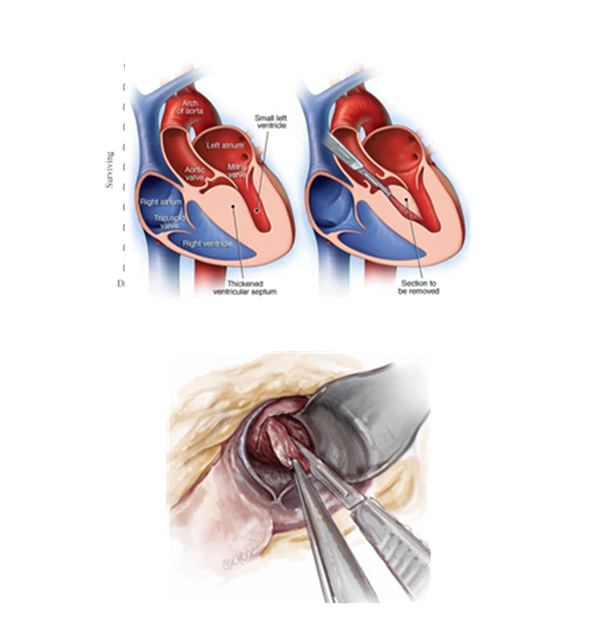
[Overview of myocardial resection (top) and
myocardial resection through thoracotomy (bottom)]
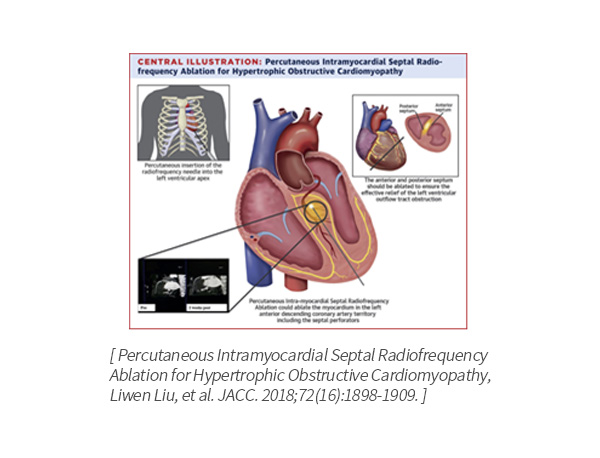
Various trials for non-invasive treatment of hypertrophic cardiomyopathy and ventricular septal radiofrequency cauterization treatment technology
Intraseptal RF ablation
The world's first trial in intraseptal RF ablation using a high-frequency electrode to ablate the myocardium by using a thick myocardial needle in China, was recently introduced and eventually, published in 2018 in JACC (Journals of the American College of Cardiology) due to its excellent therapeutic prognosis.
On the other hand, this newly introduced treatment can be evaluated an inadequate approach because this approach still requires to penetrate the heart from the chest wall with a thick needle.
Therefore, our company, Tau-PNU Medical has developed a novel catheter-based intraseptal RF ablation technology, access directly to ventricular septum of heart with venous system, and it can be applied to HOCM patients immediately as a safer and more convenient alternative.
There are 36,000 new cases of HOCM annually, and catheter-based treatment is estimated to have a market of $400 million (KRW 500 billion) annually, targeting 20% of these patients.
In addition, with the expansion of the intravascular RF ablation catheter, it is estimated to have a market size of $500 million (KRW 600 billion) per year for preemptive ablation before TMVR treatment (mitral valve replacement), and $60 million (KRW 70 billion) per year for intramyocardial ablation for ventricular tachycardia treatment.
Thru-Septal Pacing
The pacemaker market (electrotherapy of bradycardia or heart failure) size is accounted for $15 billion USD.
Current pacemaker treatment uses a method of placing a lead on the apical right ventricle and applying electrical stimulation, which has a serious disadvantage of (1) heart failure due to a delay in ventricular electrical conduction (wide QRS) (2) tricuspid regurgitation (20-30%).
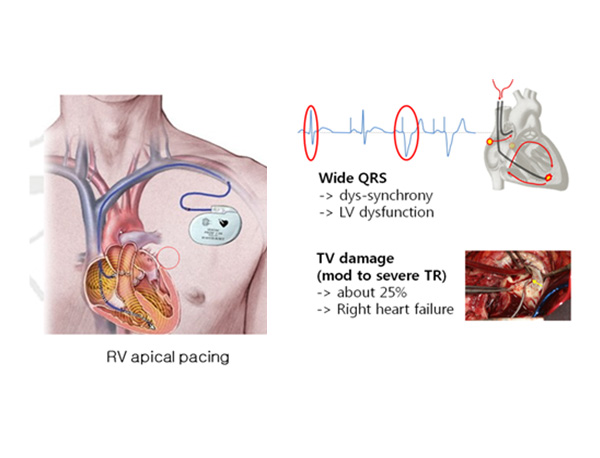
[Limits of Conventional Pacemaker Therapy]
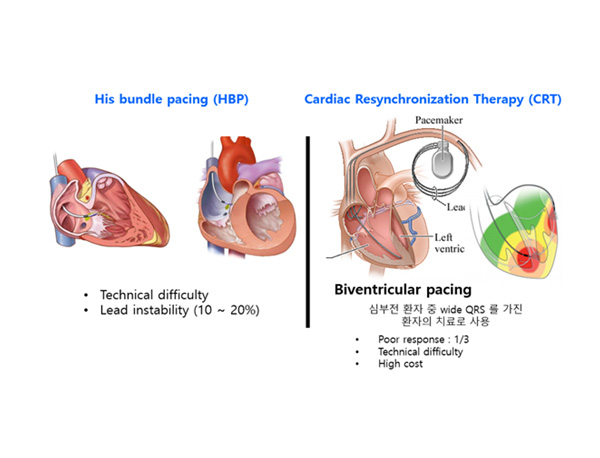
To overcome these shortcomings, there are His bundle pacing (HBP) that provides electrical stimulation by placing a lead in His bundle, the electrical conduction system of the ventricle, or CRT that performs biventricular pacing by applying stimulation from two ventricles. However, both methods are not easy to apply because the procedure is not convenient and expensive (2~30 million KRW), and in the case of HBP there is a risk that the lead may be dropped out.
The Difference between His Pacing and Thru-Septal Pacing
Our technology can access directly to ventricular septum of heart with a simple minimally invasive operation that impacting on the overall electrical conduction system of the heart. Technically, our ‘His Pacing’ and ‘Thru-Septal Pacing’ have vital role to deliver electrical impulse (signal) directly to the the His bundle, core axis of the cardiac conduction pathway, and vicinity.
His Pacing
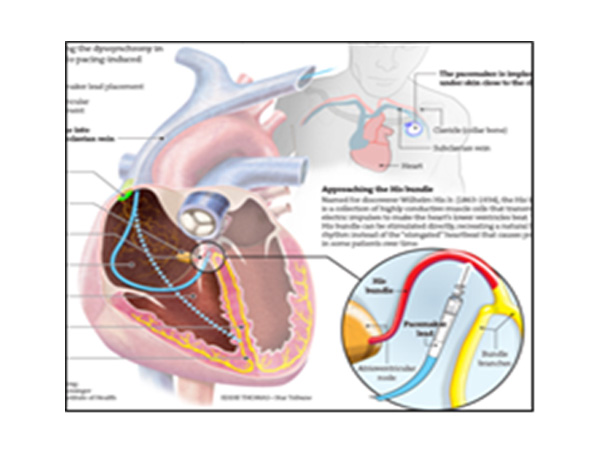
Thru-Septal Pacing
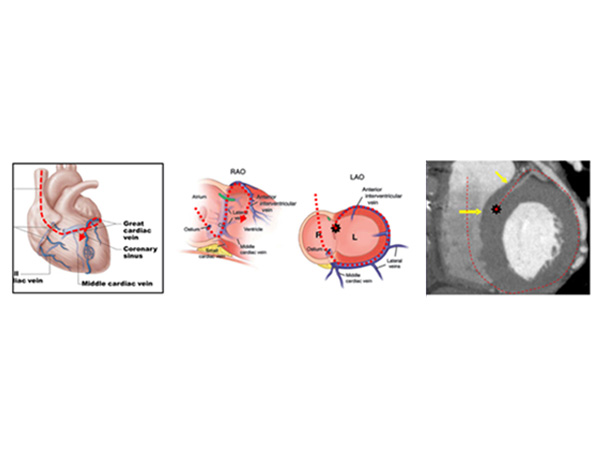
| His Pacing | Thru-Septal Pacing | |
|---|---|---|
| Target | His bundle and adjacent tissues | His bundle and adjacent tissues |
| Approach | Right atrium and right ventricle | Coronary sinus and ventricular septal veins |
| Applicable pacemaker leads | Only available with Medtronic's Select Secure 3830 lead | All leads of over the wire type can be used (Medtronic, Boston, St Jude, etc.) |
| Clinical Data | Holds Relatively Rich Clinical Data | Obtaining Initial Clinical Data |
| Disadvantage (Downside) |
1. In 10-20% of patients, it is difficult to locate the lead by finding the appropriate point. 2. The high Pacing output causes shortening of the life of the pacemaker battery. |
1. General surgeons need education on the procedure as a new approach to treatment 2. In addition to the pacemaker's general device tools, accessory devices necessary for the procedure are required (this is the company's development item) (this is the company's development item) 3. The procedure is affected by the septal vein structure. |
| Advantage (Upside) |
Positioning as a new alternative to pacemaker and ventricular synchronization therapy | Provides wider treatment opportunities as an alternative to other approaches for His pacing |

